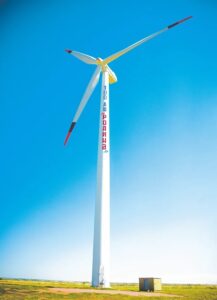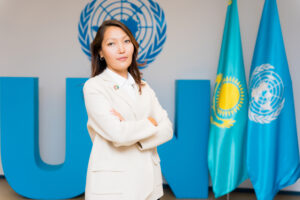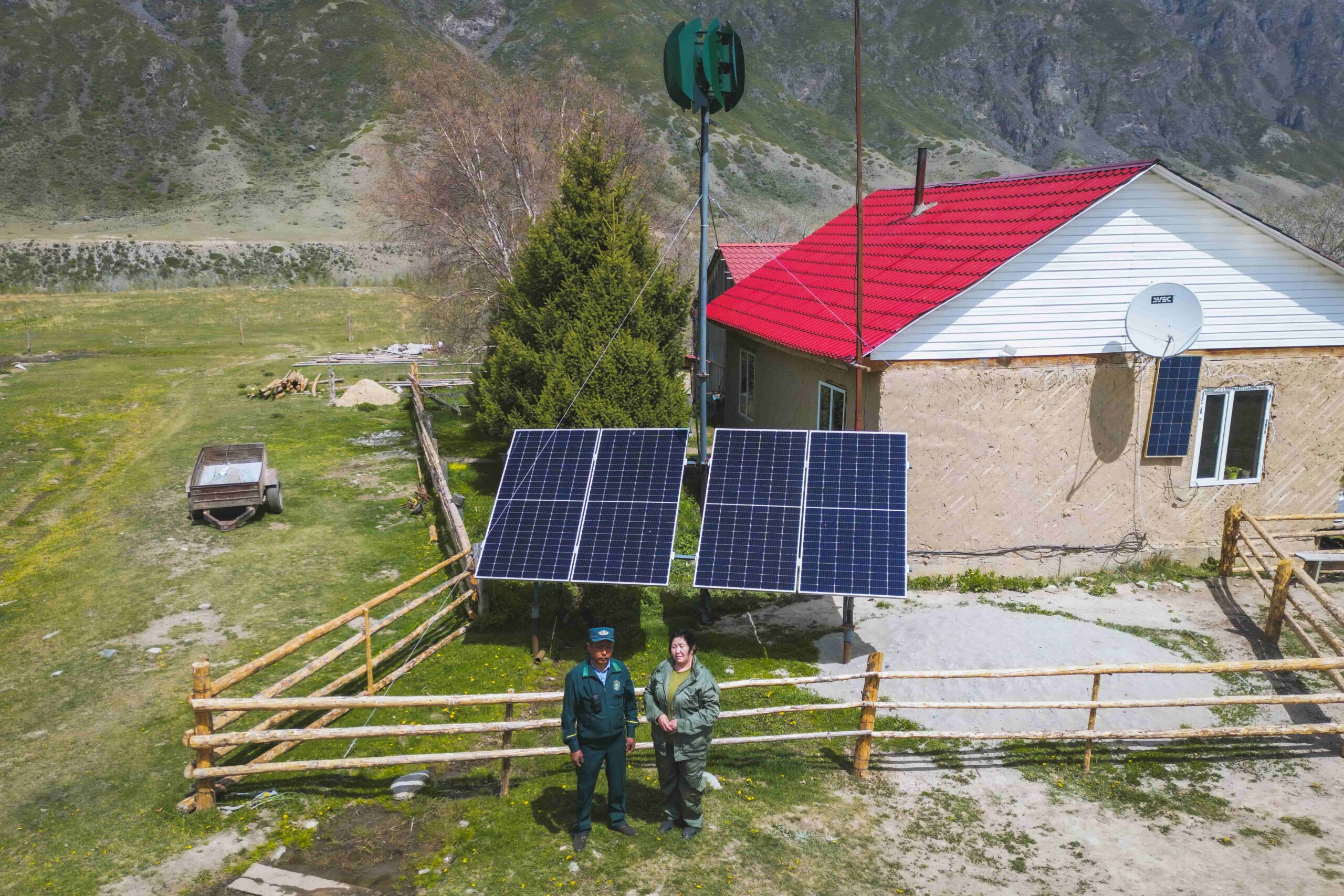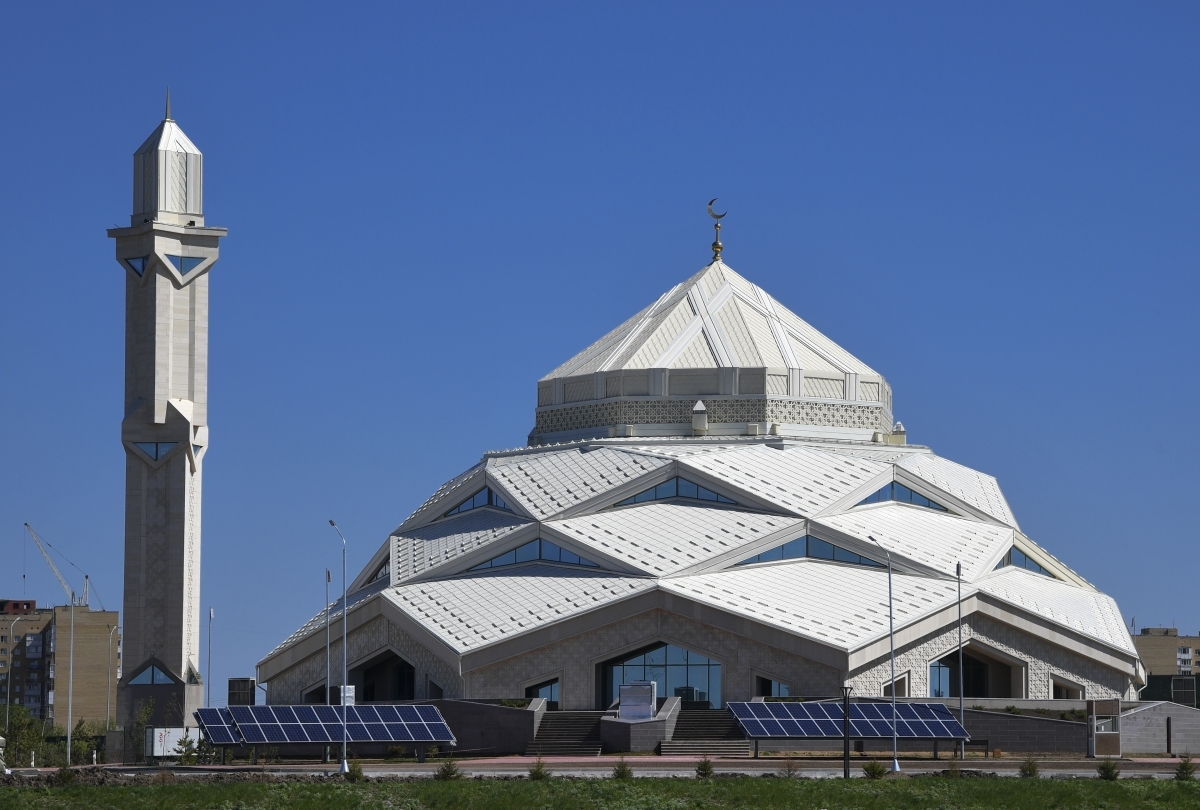ASTANA – Rodina (Motherland) village, located 70 kilometers from the capital city Astana in the middle of the steppe, is the kind of spot the nation sees as the future of energy. Having its own wind turbines, the Rodina village generates enough electricity to meet its needs.

In 2020, Kazakhstan reached the declared 3 percent share of renewable energy in electricity generation. Photo credit: ebrd.com
The village is one of the few examples of how a quiet revolution toward renewable energy is taking place nationwide.
Current data
The majority of the current renewable energy generation in the country comes from wind energy. By the end of 2022, the volume of renewable energy generation reached 5.11 billion kilowatts per hour (kWh), with the highest share coming from wind – 2.4 billion kWh, the data from the Kazakh Ministry of Energy indicates.

Wind turbine in Rodina village. Photo credit: toorodina.com
As of 2022, the proportion of electricity Kazakhstan generates from renewable sources reached 4.53%, slowly moving to ambitious targets the country has set to bring the share of renewable energy to 15% by 2030 and 50% by 2050.
The targets are envisioned in the concept of transition to a green economy, which Kazakhstan adopted in 2013. The 2030 target was initially 10% but was changed in 2021 due to the “new realities and the current positive dynamics.”
According to the data from the ministry, as of 2022, 130 renewable energy facilities were installed in the country with a total capacity of 2,400 megawatts (MW), including 46 wind farms, 44 solar power plants, 37 hydroelectric power plants and three biomass power plants.
Twelve were commissioned in 2022, with a total investment of 180 billion tenge (US$403 million). In 2023, Kazakhstan plans to put into operation 15 facilities with a total capacity of 276 MW.
Auction system
The nation transitioned to the auction system in 2018, a competitive bidding process where renewable energy developers submit their proposals to secure contracts for supplying electricity to the grid. Every year, the ministry approves the schedule of auction bidding, with a breakdown by type, capacity and region, which is published on the ministry’s website.
The UNDP has supported Kazakhstan in this effort.
“[This is] an auction with pre-developed project documentation or a site-specific auction, with a high level of preliminary elaboration [permissions, grid assessment, land use rights]. This approach increased certainty for the potential investors and developers, reduces risks and helps them to offer the lowest price for 1 kWh of green energy. The first such auction took place in 2019 for a 50 MW solar power plant in Turkistan, and this was followed by a dozen similar auctions. The new approach garnered the interest of international organizations such as the EBRD and others, who collaborated to provide their financial support to the recipients of the auction,” said Assel Nurbekova, Programme Analyst of the Energy and Environment Department at the United Nations Development Programme in Kazakhstan, in an interview for this story.

Assel Nurbekova. Photo credit: UNDP Kazakhstan
According to the Kazakh energy ministry, 15 renewable energy projects were selected at the auction in 2022, with a total capacity of 440 MW, obtaining a record low price of 12.49 tenge, circa 3,5 cents. The majority, 400 MW, came from wind energy, again.
Nurbekova noted the need for additional efforts to support “small-scale distributed renewable energy generation,” such as rooftop solar panels, solar water heaters, and biomass boilers.
“The main barrier to this is low energy tariffs: small-scale consumers compare the subsidized cost of energy from the grid to the cost of energy they can potentially generate, and this comparison discourages them. The problem can be solved either by raising [market] tariffs, providing subsidies to small green energy investors, or by a combination of both. However, small-scale solar power generation is becoming popular in remote areas where they compete with gasoline and diesel generators, and biomass boilers are becoming more popular in northern regions where straw and wood waste can be used as fuel,” she explained.
Key policy and regulatory framework
In addition to the first law on supporting renewable energy adopted in 2009, an auction mechanism, and 20 years power purchase agreement with the off-taker, as well as taxes and investment preferences (a contractual agreement between energy buyers and sellers), another key document is the strategy for achieving carbon neutrality signed by President Kassym-Jomart Tokayev last February.
“This is an important visionary document, spelling ways and setting targets and milestones for the green transition of the country, detailed to the sectors of the national economy and international commitments,” said Nurbekova.
UNDP supports Kazakhstan in improving the standards of legislation related to the development and implementation of policies, programs and regulations to reduce investment risks and increase investment to achieve renewable energy goals.

To address the electricity shortage, modern wind and solar power plants were installed in the Kolsai national park at the initiative of the UNDP and the Global Environment Facility (GEF). Photo credit: UNDP Kazakhstan
“Currently, UNDP provided the Ministry of Energy with new recommendations to boost the development of small-scale renewable energy, and now we are working with Mazhilis [lower house of the Kazakh Parliament] to reflect them in the renewable energy law,” she added.
Challenges ahead
Attracting investments into the sector remains a key challenge for Kazakhstan. Nurbekova underlined how important transparency, stability, and certainty are for investors.
“In this regard, any potential modifications in the electricity market, particularly the introduction of the off-take mechanism, necessitate a transparent and comprehensible approach. It is imperative to engage in detailed discussions with the investor community, allowing ample time for refining these changes and implementing them in a manner that enables investors to effectively plan ahead,” she said.
Among the factors discouraging potential investors and raising uncertainty is also the volatility of the national currency, as the main equipment and technology are exported to Kazakhstan. To address this problem, in 2022, the ministry introduced a mechanism of tariff indexation for the construction period. Previously, tariff indexation was possible only from the moment of commissioning of a facility.

Solar panels in the Turkistan Region in southern Kazakhstan. Photo credit: UNDP Kazakhstan
Nurbekova stressed the carbon neutrality strategy indicates the need for more than $600 billion in investments to reach the 2060 target, where just 4% is expected to come from the public sector and the rest from the private sector.
“Mobilizing this enormous volume and creating favorable conditions for investors is regarded as a task for the government and the state, and this understanding and willingness to support is extremely encouraging,” she said.
The low density of the population and the need to transport energy to large distances raises investment needs, she said.
“However, this issue is also creating some niches for wider renewable energy application in remote areas and the introduction of so-called distributed renewable energy,” said Nurbekova.
All targets set by Kazakhstan only relate to electricity but do not apply to other essential sectors such as heating, transport and households. However, the nation’s grid is not ready for a big volume of renewable energy, as most require significant upgrades.
Approximately 70% of all electricity is generated from coal, and experts say Kazakhstan cannot afford to abandon it completely.
To make the system more sustainable, the nation still needs to accelerate steps to develop its own production and technology and expand national content in the development of renewable energy sources.
Public support
In Kazakhstan, more than 90% of the public supports the government’s transition to renewable energy sources, according to the UNDP sociological survey on public awareness about the development of renewable energy sources released in February. The survey included 2,546 respondents from all regions of the country, including representatives of business, academia, associations and industry experts.
Respondents named solar and wind energy the most promising energy sources in their regions. Facts show the same picture.

Photo credit: UNDP Kazakhstan
Many stories of Kazakh citizens who have taken responsibility for their energy consumption serve as inspiring examples of how small actions can make a difference. Challenging social values, perceptions and habits regarding energy usage at home plays a pivotal role in reducing energy consumption.
For Mariyam Kassymova, an eco trainer and eco blogger from Astana, environmental friendliness is not a habit but a lifestyle.
“The brightest example is EXPO, known to everybody, built with green technologies. But I would like to bring another example that may not be known so widely. It is a mosque [Yryskeldy kazhy], which consumes zero energy because they have installed solar energy batteries,” she told The Astana Times.
Solar panels provide sufficient energy to the mosque. “Whatever remains, they sell it to Astana Energosbyt [city’s electricity communal service] by agreement,” she added.
She also brought the Rodina village as an example.

The Yryskeldi mosque in Astana generates electricity from solar panels. Photo credit: kazpravda.kz
“If we consider organizations or households, society is not yet at that progressive level. There are some interesting examples, though. I was once passing by a residential complex where I saw solar panels on one of the floors. But obviously, I can assume this person is knowledgeable in this matter, aware of how it should be installed and, most importantly, how it transforms into the energy,” she said.
She highlighted the example of Türkiye, where many households use alternative energy sources.
“I just recently returned from Türkiye. This is a wonderful example. Almost every household has a solar battery, which reduces energy use, and also water boilers, thereby they use solar energy. I think this decreases electricity use many times. I hope we can reach that level one day. Of course, we have different climate conditions compared to Türkiye and sunny day is much shorter, but at least renewable energy can meet some part of energy needs,” she said.

